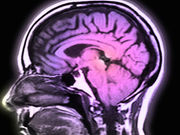Those with slow-growing gliomas lived five years longer, on average, than those who got only radiation
THURSDAY, April 7, 2016 (HealthDay News) — Adding chemotherapy to radiation treatment may add years to the lives of patients with grade 2 gliomas, according to research published in the April 7 issue of the New England Journal of Medicine.
Jan Buckner, M.D., chair of oncology at the Mayo Clinic in Rochester, Minn., and colleagues recruited 251 patients between 1998 and 2002. Half were randomly assigned to have six weeks of radiation therapy alone, while the other half had radiation followed by chemotherapy with procarbazine, lomustine, and vincristine. When possible, the participants had some of the cancer surgically removed before undergoing radiation. The patients ranged in age, but they were typically about 40 years old.
By the end of the study period, 55 percent of the study group had died. But patients who’d received chemotherapy lived longer — typically surviving for 13 years, versus eight years among those who’d received only radiation. The most common toxic effects were grade 1 or 2: fatigue, anorexia, nausea, and vomiting. Toxic effects of grade 3 or 4 were uncommon, except for neutropenia. Twenty-two percent of patients eventually showed some type of cognitive effect, such as memory difficulties — but those were related to the radiation, Buckner told HealthDay, not the chemotherapy.
“Although there appears to be a small cohort of patients with grade 2 glioma who do not benefit from radiation therapy plus chemotherapy, the identification of those patients remains elusive,” the authors write. “The magnitude of treatment benefit from combined chemotherapy plus radiation therapy is substantial, but the toxic effects are greater than those observed with radiation therapy alone. Patients and their physicians will have to weigh whether the longer survival justifies the more toxic therapeutic approach.”
Copyright © 2016 HealthDay. All rights reserved.








